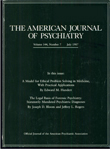Lithium Maintenance Treatment of Depression and Mania in Bipolar I and Bipolar II Disorders
Abstract
OBJECTIVE: Effects of long-term lithium treatment for depressive and manic phases of type I and type II bipolar disorders were compared. METHOD: Clinical research records of 317 patients with DSM-IV-defined bipolar disorder (188 with type I and 129 with type II) were analyzed for frequency and duration of affective episodes and hospitalizations before (mean=8.38 years) versus during (mean=6.35 years) lithium maintenance treatment. Treatment effects were also assessed by survival analysis of interepisode intervals and by multivariate regression testing for factors associated with response to treatment. RESULTS: Bipolar I and bipolar II patients were ill before treatment a similar percentage of time, but the subtype distinction was supported descriptively. Lithium had superior benefits in type II patients, with significantly greater reduction of episodes per year and of the percentage of time ill. Reduction of depressive morbidity was similarly strong in both diagnostic types. During treatment, bipolar II patients had 5.9-fold longer interepisode intervals and were twice as likely as type I patients to have no new episodes. Starting lithium maintenance earlier predicted greater improvement. CONCLUSIONS: Lithium maintenance yielded striking long-term reductions of depressive as well as manic morbidity in both bipolar disorder subtypes, with greater overall benefits in type II patients and with earlier treatment.



